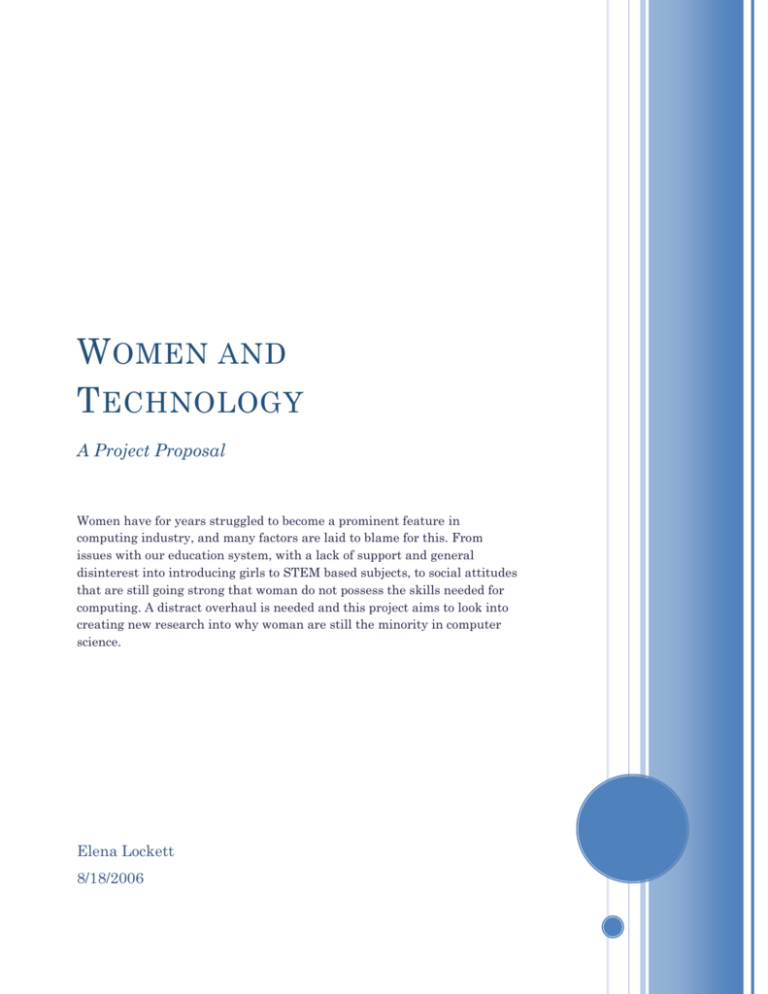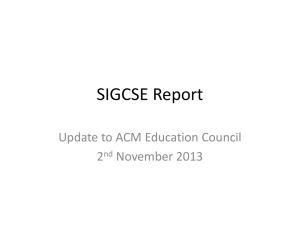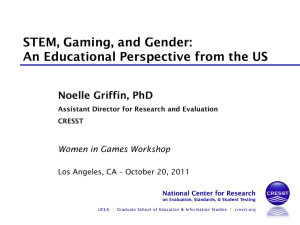Women and Technology - Lancaster University
advertisement

W OMEN AND T ECHNOLOGY A Project Proposal Women have for years struggled to become a prominent feature in computing industry, and many factors are laid to blame for this. From issues with our education system, with a lack of support and general disinterest into introducing girls to STEM based subjects, to social attitudes that are still going strong that woman do not possess the skills needed for computing. A distract overhaul is needed and this project aims to look into creating new research into why woman are still the minority in computer science. Elena Lockett 8/18/2006 WOMEN AND TECHNOLOGY A Project Proposal 1. Problem Statement In today’s modern world, gender equality is battled for and we strive to ensure the sex of a person in no way obstructs their aims and goals in life. Wages for men and women are on their way to being equal, sexist behaviour is frowned upon and no longer do we live by the stereotypical nature that a man earns the living and the woman makes a home. So why, in this apparently modernized world, do women still remain the minority in STEM based subjects such as, mathematics, science and computing. In a world where more females attend university than males1, women still continue to only make up a disproportionately small segment of Computer Science majors2. Many factors have been attributed towards the shocking decrease in both women achieving degrees in Computer Science subjects and then continuing to work in those Computer Science subject areas; lack of female role models, gender stereotypes, peer pressure and general lack of interest in the STEM subjects. The aim of this project is to gain a deeper understanding into why women still steer away from working in Computing. How the idea that a women is incapable of achieving in a Computer Science subject is seen as normal and socially acceptable in the 21st century. To actually listen to women and their experiences of how they were influenced into choosing their career path/degree specialism. To gain a better understanding to why a social stigma still revolves around Computing and why this continues to disenchant females. The report consists of a background into the research area, primarily focusing on literature review of other similar studies, including specific studies into Ratcliffe, R. (2013). The gender gap at universities: where are all the men?. Available: http://www.theguardian.com/education/datablog/2013/jan/29/how-many-men-and-women-arestudying-at-my-university. Last accessed 21st May 2014. 2 Beede, D. Julian, T. Langdon, D. McKittrick, G. Khan, B Doms, M. (2011). Women in STEM: A Gender Gap to Innovation . U.S. Department of Commerce, Economics and Statistics Administration 11 . #04-11 (1), 1. 1 girls and computing. The different forms of methodology intended to be used to gain more knowledge about girls who study STEM subjects such as interviews, surveys etc. and then how this data will be analysed and then linked with previous studies and research, to show common themes and areas of importance. Details of implications for education and Computing can be found in the future work sections and any possible resources that may be needed to further my studies. Finally, any included references used in this proposal. 2. Literature Review Due to extremely obvious lack of females in the computing industry, a large amount of time and effort has been dedicated towards the understanding into why the figures of male and females students partaking in computing courses are so vastly different. A lot of attention has placed upon the fact that education that girls receive has swayed them away from the sciences3 (Rossiter 1982; Keller 1985; Harding 1996), to the extent that gender stereotyping still thrives in our education system, influencing girls and boys towards different subjects in secondary and tertiary education and thus influencing the segregation between men and women in the workplace. At the most impressionable age, if children are told girls do these subjects and boys do those, how are they expected to see this as unusual, when educators (who they are taught to trust and listen to) teach them stereotypes like this. Of course, the argument that girls simply don’t want to do computing is used to make figures like, “the percentage of jobs held by women in computer science, is lower today than it was in 1983”4 (Commission on Professionals in Science & Technology, 2004) seem acceptable or in extreme cases, researchers even state women are unsuited because they lack the ability needed, implying that men possess some knowledge that women cannot have or learn to have. Children should be told from a young age, to aim high and pursue their dreams, and if girls are taught they are unsuitable for a certain subject, what is stopping them thinking that about others? A change in teaching methods and opinions teachers hold needs to be addressed. Computing is clouded in the idea that is solely a male only subject, with various stereotypes of the atypical computing student still being connected to the department. Even male Wajcman, J. (2007). From Women and Technology to Gendered Technoscience. n/a. 1 (1), 288. 4 Singh, K. Allen, K. Scheckler, R. Darlington, L.. (2007). Women in Computer-Related Majors: A Critical Synthesis of Research and Theory from 1994 to 2005. Review of Educational Research. 77 (4), 501. 3 computing professionals stereotype computing with other typical male behaviours that allow men to “grow chest hair, spit, chew, bench 250 pounds and write a computer program”5 People state they don’t let public opinion and peer pressure influence their decisions but it could help explain the differences in male/female participation, due to the lack of encouragement and the unattractive image portrayed by the subject, which dissuades a large amount of females, but not all as recent studies show 25 percent of large sized undergraduate Computer Science departments are made up of women6. People look up to role models, so if women have no female role models in the computing industry, how can they start to perceive computing in a way they find both attractive and endearing. In such a male dominated industry, a women would be lucky to not feel singled out and maybe not have the confidence they would have in an equally divided gender occupation. The cultural context of computing can have an effect on the self-confidence on those women who do decide to pursue an education/career in computing, as stereotypes about whether a woman is able to progress in computing would clearly affect their entry, performance and persistence to achieve by reducing their own self-confidence.7 Positive research has also been conducted throughout the years, to help create and build up a greater knowledge of what helps women decide to embark on a career in computing, knowledge that can hopefully be transferred to the education system to change the stereotypical air about computing. Undergraduate women partaking in Computer Science majors often do so because computing seems to fit their personal strengths best, they have encouragement from family and social peers and it allows them to be creative in their own way8. Another study focused on the fact that although girls may be partaking in computer science majors, the percent that continue in computer-related occupational fields falls vastly9 (Bartol & Aspray, 2006) so perhaps more needs to be done to increase the attractiveness of the computing sector. Cohoon, J. (2003). Must There Be So Few? Including Women in CS. SIGCSE. n/a (n/a), 670. Cohoon, J. (2003). Must There Be So Few? Including Women in CS. SIGCSE. n/a (n/a), 671. 7 Cohoon, J. (2007). Gendered Experiences of Computing Graduate Programs. SIGCSE. n/a (n/a), 547. 8 Cohoon, J. (2002). Recruiting and Retaining Women in Undergraduate Computing Majors. SIGCSE Bulletin. 34 (2), 48. 9 Singh, K. Allen, K. Scheckler, R. Darlington, L.. (2007). Women in Computer-Related Majors: A Critical Synthesis of Research and Theory from 1994 to 2005. Review of Educational Research. 77 (4), 502. 5 6 3. Methodology The ethical policies of the School of Computing and Communications at Lancaster University are to ensure informed consent of all participants will be strictly followed and UK and EU guidelines on the collection, storage and use of data to ensure anonymity, confidentiality, privacy and security will be implemented. The aim of the project is to build a better understanding into why women still shy away from STEM based subject choices, thus reducing the amount of women in the workplace for those subjects. Many different types of research have been dedicated to finding the problem and the best way to see first-hand why females are pushed away from Computing is to conduct a range of research methods to build a collection of data that can be analysed and compared to previous findings to detect patterns. Three different methods of methodology are going to be used; interviews, autoethnography and survey. i. Interviews Qualitative research interview seeks to cover both a factual and a meaning level, which is perfect to help understand what prior experiences have allowed negative connotations towards women and computing to become the norm. Interviews allow control to hand over to the interviewee, giving them more freedom to properly express their thoughts and feelings towards a topic and as the subject area can be quite a personal one, conducting semi structured interviews, where flexibility is allowed, seems most appropriate. Due to the differences in age of the target interviewees, different tactics will have be deployed as students studying at university level will response better to more open-ended compared questions compared to students studying at primary school, who will need more structure in their questioning, with more emphasis upon picture based questions/video aids. As interviewees of a young age will be harder to engage, more interactive techniques will need to be put in place such as, setting drawing tasks and asking the child to draw a scientist (to then see if they draw a man or a woman, thus proving if gender stereotypes still exist). This format of research provides reliable, qualitative data, due to the inclusion of open-ended questions to ensure important topics are stuck to. Pilot interviews will need to be conducted to ensure appropriate, questions are developed, that will ensure the research will reach its full potential. ii. Auto-Ethnography Auto-Ethnography is “an approach to research and writing that seeks to describe and systematically analyse personal experience”10 and due to the personal connotations to the subject of women and computing, it’s beneficial to use these personal views to an advantage. Using a personal approach, can be helpful to aid understanding into whether experiences affect life choices (for example, whether having a positive teaching experience, directly affects the emotions a person feels towards that subject/topic). Although not as reliable as interviews, it allows a freer, more honest and open account than semi-structured interviews which can help push interviewees to the answer the interviewer desires. Auto-Ethnography will solely focus on myself and my own experiences, to not only justify motivation but also provide another source of evidence to the cause. iii. Survey Survey methodology allows a sample of data to be inspected, rather than specifying interviewing the target market, it allows different rationales of people to questioned and thus helps provides a more rounded review of opinions. It might not be the primary concern to interview students who study non-STEM subjects but it would help create a more 3-dimensional view of why students do computing and why they don’t. A sample of participants would need to be selected, to ensure they are appropriate for the survey and once they’ve taken part in the survey, the result need to be analyzed and check for accuracy/patterns. The questions must provide results that are useful and will be beneficial to the study such as, do you remember your ICT lessons at high school to be interesting, boring or indifferent? This question would provide backup to whether the way ICT/Computing is taught is affecting the numbers studying it. 4. Analytic Stance Once all this data has been collected using the various forms of methodology I have selected, an equally important stage of the project is ensuring the information is accurately analysed to ensure its full meaning and content is understood which will help when comparing the findings to existing studies. Ellis, C. Adams, T & Bochner, A. (2011). Autoethnography: An Overview. Qualitative Social Research. 12 (1), n/a. 10 The most accurate form of analysing this data is through grounded analysis. Another qualitative research approach, this works best with research that raises generative questions but doesn’t allow those questions to control the research, confining it to yes/no answers. Through gathering data, core theoretical concept(s) are identified which can help gauge links between the concepts and the data. There are various key analytic strategies; coding, memoing and integrative diagrams and sessions11. The coding strategy would involve categorising the data and describing the implications of the meaning of it, it is first done open coding which considers every minute detail and then moves on to selective coding. Memoing allows the researcher to record their thoughts as they work on the study, to ensure any little idea is remembered, however big or small. This allows the memos to be very open when sometimes when analysing data at the end of the study, thoughts can be become too focused on the core concept. Lastly, integrative diagrams and sessions bring all the details together, to allow theories and concepts to become linked and gain dependence upon each other. Many different forms of graphic can used, such as concept maps or simple cartoons, as long as they summarise the work. 5. Analysis Once the initial set of findings has been analysed, it can then be compared and contrasted to previous studies and existing reports. This helps show which theories have the most strength if they have significant links to a range of other studies on women and technology and will help give prominence to the theories which have been repeatedly brought up and then backed up with analysed studies. Hopefully, areas that should become clear in the issue of women and technology will bring themselves to light through this analysis, some of which might be teaching methods causing students to steer clear of certain subjects, peer pressure from fellow students or schools still not trying to aim STEM subjects towards females and thus helping deepen the gap between males and females in STEM based subjects. It will also then become apparent if any new trends/theories have made themselves apparent through the comparison to existing studies, because technology is a 11 Trochim, W. (2006). Qualitative Approaches. Available: http://www.socialresearchmethods.net/. Last accessed 20th May 2014. vastly changing environment and a lot of the studies referenced will be ‘obsolete’ in a sense due to development of computing and the way we teach it, such as, the introduction of teaching computing skills in primary schools. The results from the project will then feed into some more general understandings of gender and technology, in an overall view. 6. Implications/Future Work The main aim of this project, is to discover and provide justification and backup to existing theories and studies, thus proving which areas are attracting/repelling women from computing. To uncover some understanding and develop some sensitivities into what the possible reason for rejection of STEM subjects by women (or STEM subjects rejection of them). There are several possible implications that might come from the findings hopefully attained at different macro/micro levels in terms of new thinking about the curriculum (such as the study of women scientists etc.); new approaches to teaching and learning that are perhaps more ‘female friendly’; some work into changes of how subjects market themselves to males and females. 7. Work Schedule The project will run over the course of the year and therefore needs planning and organization to ensure tasks are done in plenty of time with space for any issues that may occur. The project is to last over 20 weeks and over this time various tasks must be done, but to ensure the project is able to being at the start of one week, reading will be done over the summer to prepare for the first challenge; designing of interview/questionnaire schedule and pilot study. Over the duration of the project, several major tasks will occur; - - - Design of interview/questionnaire (week 1-2) where questions will be prepared and trialled to ensure appropriateness and the full potential of the research is being obtained Interviews, transcriptions etc. (week 2-12) interviewing appropriate candidates (university undergraduates, primary school children) to build up a collection of data and then transcribing the interviews Analysis of data (week 13-16) using the collected data to analyse patterns and trends to work out where the fault is with computing and women Writing report (week 17-20) collating the analysed data to write a report about the implications of the results and connections to previous studies, which may lead to new studies. GANT Chart: 8. Bibliography Beede, D. Julian, T. Langdon, D. McKittrick, G. Khan, B Doms, M. (2011). Women in STEM: A Gender Gap to Innovation . U.S. Department of Commerce, Economics and Statistics Administration 11 . #04-11 (1), 1. Cohoon, J. (2002). Recruiting and Retaining Women in Undergraduate Computing Majors. SIGCSE Bulletin. 34 (2), 48. Cohoon, J. (2003). Must There Be So Few? Including Women in CS. SIGCSE. n/a (n/a), 670. Cohoon, J. (2003). Must There Be So Few? Including Women in CS. SIGCSE. n/a (n/a), 671. Cohoon, J. (2007). Gendered Experiences of Computing Graduate Programs. SIGCSE. n/a (n/a), 547. Ellis, C. Adams, T & Bochner, A. (2011). Autoethnography: An Overview. Qualitative Social Research. 12 (1), n/a. Ratcliffe, R. (2013). The gender gap at universities: where are all the men?. Available: http://www.theguardian.com/education/datablog/2013/jan/29/how-many-men-andwomen-are-studying-at-my-university. Last accessed 21st May 2014. Singh, K. Allen, K. Scheckler, R. Darlington, L.. (2007). Women in Computer-Related Majors: A Critical Synthesis of Research and Theory from 1994 to 2005. Review of Educational Research. 77 (4), 501. Singh, K. Allen, K. Scheckler, R. Darlington, L.. (2007). Women in Computer-Related Majors: A Critical Synthesis of Research and Theory from 1994 to 2005. Review of Educational Research. 77 (4), 502. Trochim, W. (2006). Qualitative Approaches. Available: http://www.socialresearchmethods.net/. Last accessed 20th May 2014. Wajcman, J. (2007). From Women and Technology to Gendered Technoscience. n/a. 1 (1), 288.








